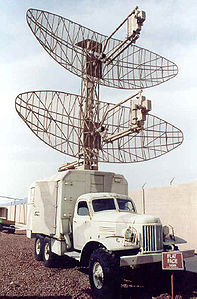- P-15 radar
-
P-15 Radar P-15 Flat Face A at Nellis AFBCountry of origin  Soviet Union
Soviet UnionIntroduced 1955 Type Surveillance/Target Acquisition Frequency UHF Range 150 km Altitude 3 km Diameter 11 meters Azimuth 360 degrees Elevation 2-14 degrees Precision 0.3 km range Power 270 kW The P-15 "Tropa" (Russian: "Тропа"; English: "trail") or 1RL12 (also referred to by the NATO reporting name "Flat Face A"in the west) is a 2D UHF radar developed and operated by the former Soviet Union.
Contents
Development
In 1952 SRI-244 started development of what become the P-15 early warning radar, by 1955 the radar had passed state trials and was accepted into service with the anti-aircraft troops of the Soviet armed forces[1]. The P-15 was designed to detect aircraft flying at low altitude and came to be associated with the S-125 "Neva" anti-aircraft system (NATO reporting name SA-3 "Goa"), though it was later replaced by the P-15M2 "Squat Eye" radar which mounted a single radar antenna on a 20-30 meter mast to improve coverage[2].
In 1959 the modernised P-15M "trail" radar passed through the state test program, the modernisation replacing outdated mercury based electronics. In 1962 another modernisation of the P-15 passed through trials as the P-15N, the radar being developed and produced by the Ulyanovsk Mechanical Plant[1]. The P-15N introduced a more sensitive receiver which improved the detection range and a new amplifier for the transmitter. Further improvements were made in 1970 when the P-15MN passed trails, the P-15MN included a pulse coherent Doppler filter (moving target indicator) to remove passive clutter (by up to 50 dB)[1], the first radar to employ the method in the Soviet Union[3]. Finally by 1974 the modernisation of the P-15 was so extensive that it resulted in a new designation, the P-19 "Danube" also known as the 1RL134 and known in the west as the Flat Face B.
Description
The P-15 is a high mobility radar and with the antenna mounted directly on the single truck (Zil-157) used for transport and the system was able to be deployed and taken down in no more than 10 minutes.[4]. The P-15 uses two open frame elliptical parabolic antenna accomplishing both transmission and reception, each antenna being fed by a single antenna feed[5]. The radar can rapidly shift its frequency to one of four pre-set frequencies to avoid active interference with passive interference being removed by a coherent doppler filter[1]. Azimuth was determined by mechanical scanning with an associated accompanying PRV-11 (NATO reporting name "Side Net") used to determine elevation[2]. A secondary radar for IFF is generally used in conjunction with the P-15, generally the 1L22 "Parol".[5]
Operators
The P-15 was operated by the Soviet Union from 1955 and though it has since become obsolete it was passed down to successor states after the fall of the Soviet Union, it has been largely superseded by its successor the P-19.
See also
External links
References
- ^ a b c d "РЛС П-15 "ТРОПА"" (in Russian). pvo.guns.ru. 2000-08-07. http://pvo.guns.ru/rtv/p15.htm. Retrieved 2009-01-06.
- ^ a b "P-15 FLAT FACE". Global Security. 2000-2009. http://www.globalsecurity.org/military/world/russia/flat-face.htm. Retrieved 2009-01-06.
- ^ V.S. Chernyak, I. Ya. Immoreev and B.M. Vovshin (2003). "Radar in the Soviet Union and Russia: A Brief Historical Outline". IEEE AES Systems Magazine, (December): 8–12.
- ^ Christian Wolff (2008). "P- 15 „Flat Face A”". http://www.radartutorial.eu/19.kartei/karte908.en.html. Retrieved 2009-01-06.
- ^ a b "P-19 series early warning radar (Czech Republic), LAND-BASED AIR DEFENCE RADARS". Jane's Radar and Electronic Warfare Systems. 2008-03-03. http://www.janes.com/extracts/extract/jrew/jrew0071.html. Retrieved 2009-01-06.[dead link]
Categories:- Russian and Soviet military radars
Wikimedia Foundation. 2010.


